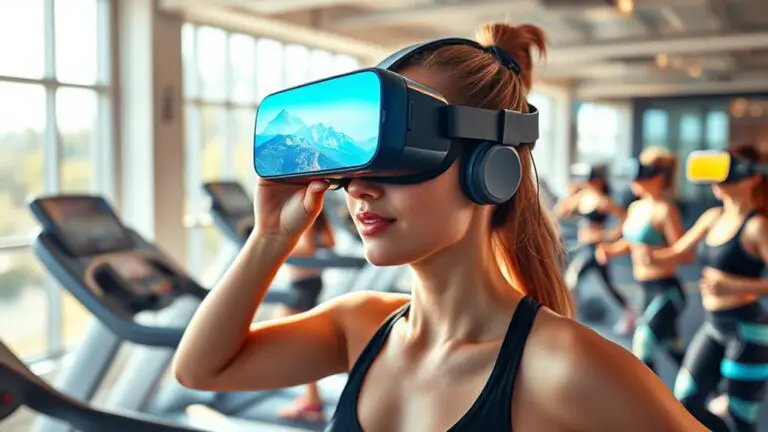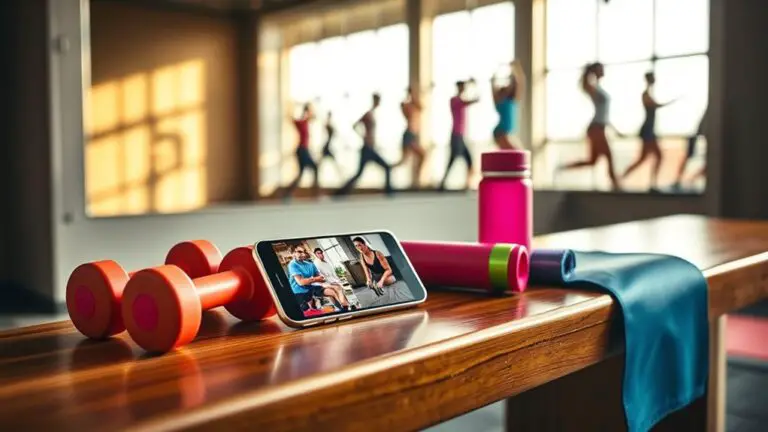The Power of Visualization in Gym Performance

The power of visualization in gym performance can’t be underestimated. By mentally picturing successful lifts, you can activate neural pathways similar to physical execution, enhancing your strength and technique. This practice boosts your confidence and keeps you focused, especially during challenging workouts. When you consistently visualize your success and goals, you reinforce a positive mindset that propels you forward. Imagine how these strategies can transform your routine into a powerful vehicle for achievement and growth.
Understanding Visualization and Its Impact on Performance

When you consider the mental aspects of gym performance, visualization emerges as a powerful tool that can greatly enhance your results. This technique, often referred to as cognitive rehearsal, involves mentally picturing yourself executing exercises successfully. By vividly imagining each movement, you’re not just dreaming; you’re training your brain to respond more effectively during actual workouts.
Studies show that athletes who incorporate visualization into their routines experience significant performance enhancement. Why? Because your mind doesn’t distinguish between real and imagined experiences. When you visualize, you’re fundamentally programming your brain to react and perform in specific ways, reducing anxiety and boosting confidence.
Additionally, this practice helps you refine your technique, allowing you to focus on the nuances of each lift or movement. So, make visualization a regular part of your training; it can bridge the gap between potential and performance, setting the stage for remarkable gains in the gym.
The Science Behind Visualization Techniques
Although many may underestimate its power, the science behind visualization techniques reveals profound insights into how our brains process and respond to imagined scenarios. Neuroscience insights demonstrate that when you visualize an action, your brain activates similar neural pathways as if you were actually performing it. This means that imagery effectiveness can greatly enhance your performance in the gym.
- You can achieve a stronger mind-muscle connection.
- You’ll boost your confidence before hitting that heavy lift.
- You might find yourself motivated to push through barriers.
Psychological Benefits of Visualization for Athletes

When you visualize your performance, you’re not just imagining success; you’re sharpening your focus and enhancing your concentration. This mental practice can considerably boost your confidence levels, allowing you to tackle challenges with a stronger mindset. Furthermore, by incorporating visualization techniques, you can effectively manage stress, creating a positive mental environment for your athletic journey.
Enhanced Focus and Concentration
Visualization isn’t just about imagining success; it’s a powerful tool that can sharpen your focus and enhance your concentration during workouts. By incorporating visualization into your routine, you can employ focus techniques that keep distractions at bay, allowing you to fully immerse yourself in your training.
Consider these emotional benefits of enhanced focus:
- Increased mental clarity that helps you push through challenging sets.
- Heightened awareness of your body’s movements, improving your technique.
- Stronger motivation that drives you to achieve your fitness goals.
Utilizing concentration exercises through visualization not only prepares your mind but also sets the stage for peak performance. When your focus is laser-sharp, every rep becomes a step closer to your aspirations.
Increased Confidence Levels
Building on the enhanced focus gained through visualization, athletes often find that this practice also considerably boosts their confidence levels. When you visualize your success, you’re engaging in powerful confidence building. By mentally rehearsing your performance, you create a sense of familiarity with the challenges ahead, which can enhance your self-belief. This mental preparation allows you to approach your workouts and competitions with a more positive mindset. As you see yourself overcoming obstacles in your mind, your belief in your abilities strengthens. This self-belief enhancement translates into real-world performance, enabling you to push past limits that once seemed insurmountable. Ultimately, visualization transforms not just your focus but your entire approach to training and competition, igniting the confidence you need to excel.
Stress Reduction Techniques
Although the pressures of training and competition can be overwhelming, employing visualization techniques can considerably alleviate stress for athletes. By integrating mindfulness practices and relaxation exercises into your routine, you can create a mental sanctuary that enhances your focus and performance. Visualization allows you to mentally rehearse success, reducing anxiety and fostering a sense of control.
- Feel the weight of stress lift as you picture your perfect performance.
- Experience the calm that comes from visualizing each movement with precision.
- Embrace the confidence that arises from seeing yourself succeed.
When you visualize, you’re not just imagining; you’re training your mind to cope with challenges, leading to greater resilience and improved performance in the gym.
How Visualization Enhances Focus and Motivation

When you visualize your goals, you’re not just imagining success; you’re sharpening your focus and igniting your motivation. Mental imagery techniques can transform how you perceive challenges, helping you stay engaged and determined. By setting clear objectives and visualizing each step, you create a powerful roadmap that drives your performance in the gym.
Mental Imagery Techniques
Many athletes find that mental imagery techniques can greatly enhance their focus and motivation during training and competition. By engaging in mental rehearsal and imagery training, you can visualize yourself achieving your goals, which ignites passion and determination within you.
- Picture crossing the finish line, feeling exhilarated.
- Imagine executing perfect form, boosting your confidence.
- Envision overcoming obstacles, fueling your resilience.
These vivid mental images create a powerful connection between your mind and body, sharpening your concentration and commitment. When you consistently practice these techniques, you’ll notice an increase in your performance and drive. Visualization isn’t just a tool; it’s a transformative practice that can redefine your journey in the gym. Harness this power, and watch your potential unfold.
Goal Setting Strategies
Building on the power of mental imagery, goal setting becomes a natural extension of your visualization practice. By clearly defining your objectives, you create a roadmap for success. Visualizing your goals enhances focus, making it easier to stay motivated during training sessions. Start with SMART goals—specific, measurable, achievable, relevant, and time-bound. As you progress, use goal tracking to monitor your advancement toward performance milestones. This not only reinforces commitment but also allows you to celebrate small victories along the way. With each milestone visualized, you’ll find renewed energy and determination. Remember, the clearer your mental image of success, the more likely you are to achieve it. Harness visualization to transform your goal-setting process into a powerful motivational tool.
Techniques for Effective Visualization in the Gym
Although visualization might seem like a simple concept, its application in the gym can greatly enhance your performance. By incorporating effective visualization exercises into your routine, you’ll find that mental rehearsal can transform your workouts. Here are some techniques to harness this power:
Visualization may seem simple, but its impact on gym performance is profound, transforming your workouts through mental rehearsal.
- Picture yourself successfully completing each lift, feeling the strength surge through your muscles.
- Visualize overcoming challenges, like hitting that elusive personal record, igniting a fire in your determination.
- Create a mental image of your ideal physique, fueling your motivation to push harder every day.
These techniques not only enhance focus but also build self-confidence. When you mentally engage with your goals, you’re training not just your body, but your mind. The results? A powerful synergy that can lead to improved performance and heightened resilience. Embrace visualization, and watch how it elevates your gym experience to new heights!
Incorporating Visualization Into Your Workout Routine

Incorporating visualization into your workout routine can be a game-changer for your performance. By using visualization techniques, you can mentally rehearse your exercises, enhancing your focus and boosting your workout motivation. Before hitting the gym, take a few moments to visualize each movement. Picture yourself executing the perfect squat or lifting that challenging weight. This mental imagery not only prepares you physically but also mentally primes you for success.
During your workouts, whenever you feel fatigue setting in, tap into your visualization skills. Imagine the accomplishment you’ll feel after finishing your set or achieving your fitness goals. This connection between mind and body can greatly elevate your performance, making every session more effective.
Integrating these visualization techniques consistently will help you stay motivated and engaged, ultimately transforming your workout routine into a powerful tool for growth and achievement. Embrace the power of visualization, and watch your performance soar.
Real-Life Success Stories: Athletes Who Use Visualization
Many top athletes harness the power of visualization to enhance their performance and achieve their goals. You may find inspiration in the testimonials of those who’ve successfully integrated visualization methods into their training regimens. Consider how they’ve transformed their mental approach, leading to remarkable outcomes:
- Heightened focus: Athletes report that visualizing success sharpens their concentration during competitions.
- Increased confidence: Many share that seeing themselves succeed in their minds boosts their self-belief greatly.
- Improved resilience: Visualization helps athletes mentally rehearse overcoming challenges, preparing them for real-world obstacles.
These stories highlight the profound impact visualization can have on athletic performance. By adopting similar techniques, you could release your potential, turning your dreams into reality. Visualization isn’t just a tool; it’s a game-changer. Embrace it, and watch your performance soar!
Overcoming Mental Barriers Through Visualization

While mental barriers can often feel insurmountable, visualization offers a powerful strategy for breaking through these obstacles. By picturing yourself overcoming challenges, you’re not just dreaming; you’re engaging in cognitive conditioning that strengthens your mental resilience. Imagine each rep, each sprint, or each lift in vivid detail, focusing on the feelings of success and accomplishment. This mental rehearsal prepares your mind and body, making it easier to face real-life situations.
When you visualize your success, you’re training your brain to respond positively under pressure. This practice transforms anxiety into confidence, allowing you to push past limits you once thought were unbreakable. Remember, every athlete encounters mental hurdles, but those who utilize visualization release their potential. So, whenever doubt creeps in, take a moment to visualize your triumph, and you’ll find the strength to overcome any barrier you face in the gym.
Frequently Asked Questions
Can Visualization Improve Endurance During Workouts?
Absolutely, visualization can enhance your endurance during workouts. By incorporating endurance techniques into your mental preparation, you create a powerful mental image of yourself pushing through fatigue. This practice can help you manage discomfort and increase your overall stamina. When you visualize success, you’re not just dreaming; you’re training your mind to endure challenges. So, next time you’re gearing up for a tough workout, take a moment to visualize your strength and resilience.
How Long Should I Visualize Before My Workout?
When considering how long you should visualize before your workout, aim for an ideal duration of about 5 to 10 minutes. This timeframe allows you to employ visualization techniques effectively, helping you focus on your goals and boost your performance. The key is to find a balance; too little time might not be effective, while too much could lead to distractions. So, set aside that time, and let your mind pave the way for success!
What if I Struggle to Visualize Clearly?
If you struggle to visualize clearly, don’t worry; even great artists started with rough sketches. Try breaking it down: use specific visualization techniques like focusing on individual movements or sensations. Picture yourself lifting weights or running, engaging all your senses in the mental imagery. Consistent practice will sharpen your visualization skills over time. Remember, even the mightiest athletes faced challenges, but they didn’t give up; they adapted and improved. Keep pushing forward!
Can Visualization Replace Physical Training?
While visualization, or mental rehearsal, can greatly enhance your performance, it can’t replace physical training. These techniques improve your focus and mental readiness, but they need to be paired with actual practice to build strength and endurance. Think of visualization as a powerful tool in your training arsenal—it sharpens your mind and prepares you for challenges, but it’s the physical work that’ll truly transform your performance. Stay committed to both aspects for the best results.
Is There an Ideal Time of Day for Visualization?
Finding the ideal time for visualization can enhance its effectiveness. Morning routines can set a positive tone for your day, allowing you to mentally prepare for challenges ahead. Alternatively, evening practices can help you reflect on your day, reinforcing your goals and achievements. Experiment with both times to see what resonates with you. Ultimately, consistency is key—whenever you choose, make it a regular part of your routine to reap the benefits.





